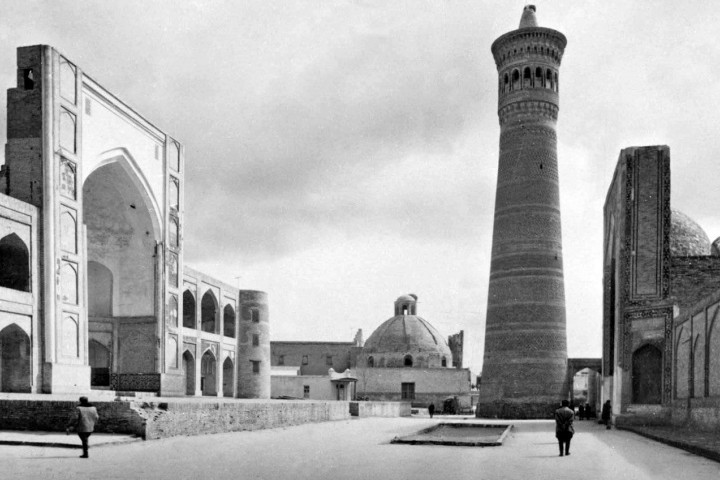10 facts about the Mir Arab Madrasa

- Construction carried out between 1530–1536
The Mir Arab Madrasa was built in the early 16th century, between 1530 and 1536. The initiative to construct this building was put forward by Ubaydullah Khan II of Bukhara. During his reign (1533–1540), he held great respect for his spiritual mentor the famous Naqshbandi sheikh Sayyid Abdullah al-Yamani (Mir Arab) and had the madrasa built in his name.
- The man behind the name — Mir Arab (Sayyid Abdullah al-Yamani)
The name of the madrasa was not chosen by chance. Mir Arab was originally from Yemen and came to Samarkand at the age of 22, becoming a disciple of Khwaja Ahrar Wali. He actively promoted the Naqshbandi order in Bukhara, as well as in places like Sabron, Vobkent, and Shofirkon. His piety, devoutness, and service to the people earned him high respect among the populace.
- Construction completed by his son-in-law, Sheikh Zakariya
In early 1536, Mir Arab passed away. The responsibility for completing the ongoing construction was entrusted to his son-in-law, Sheikh Zakariya. He fulfilled this entrusted and honorable duty, completing the building in full.
- Closed during the Soviet Era, reopened in 1945
From the late 1920s, the Soviet regime began shutting down religious educational institutions, and the Mir Arab Madrasa was no exception. However, in 1945 near the end of World War II the USSR government granted permission to open one official Islamic educational institution for Muslims. Thus, the Mir Arab Madrasa resumed its activities and for many years remained the only official Islamic educational center in Central Asia.
- A major center of religious learning for Uzbekistan’s Muslims
The madrasa hosted Muslim students from Central Asia, Kazakhstan, the Caucasus, Russia, and other regions. Here, Qur’anic studies, tafsir, fiqh, hadith, aqeedah, history, and other religious sciences were taught in depth. Today, the madrasa still operates under the jurisdiction of the Muslim Board of Uzbekistan.

- An educational system combining modern and traditional sciences
The program lasts four years, with daytime courses accepting applicants aged 15 to 35 who have a secondary or incomplete secondary education. Classes are taught mainly in Uzbek and Arabic, while Arabic, English, Russian, and Persian are also taught. Alongside religious subjects, modern general education subjects are also part of the curriculum.
- A highly complex and artistic architectural structure
The madrasa measures 68.5 × 51.8 meters overall, with a courtyard measuring 35.4 × 31.3 meters. Its monumental portal opens into a central hall with five domes, flanked by domed classrooms and a mosque on either side. There are 114 two-storey cells (hujras) arranged along each side of the building. The open courtyard with arcades has a balanced and harmonious layout.
- The mausoleum — a historic pilgrimage site
Located in the western corner of the madrasa, the mausoleum contains the carved wooden cenotaph of Ubaydullah Khan II. It also holds the graves of Mir Arab and his relatives. The interior is adorned with carved gypsum, muqarnas, and colorful tilework, making it an outstanding example of the art of its era.
- Water system and foundation stability
According to legend, before construction began, the ground was dug deep and filled with mountain stones. A special underground drainage system (tazars) was built to prevent water accumulation. This system diverted snow and rainwater from the madrasa grounds to outside the city, greatly contributing to the stability of its foundation.
- Restorations — An important step in preserving history
The madrasa underwent several restorations in the late 1970s and during the 1990s. Notably, for Bukhara’s 2500th anniversary in 1997, its portal, domes, tilework, and inscriptions were restored close to their original form. These restorations played a vital role in preserving the madrasa’s historic appearance.
The Mir Arab Madrasa is not merely an educational institution but also a major historical monument representing the religious and spiritual heritage of Uzbekistan and the entire Muslim East. Its values, architecture, and scholarly traditions remain significant today, making it an invaluable spiritual school for both the present and future generations.
Husan Tursunov
P/S: The article may be used provided that the official website of the Center is cited as the source.
Most read

Over 100 experts from more than 20 countries of the world are in Tashkent!

The Center for Islamic Civilization – a global platform leading towards enlightenment

The museum of the Center for Islamic Civilization in Uzbekistan has been further enriched: unique artifacts from different parts of the world have been presented as gifts











